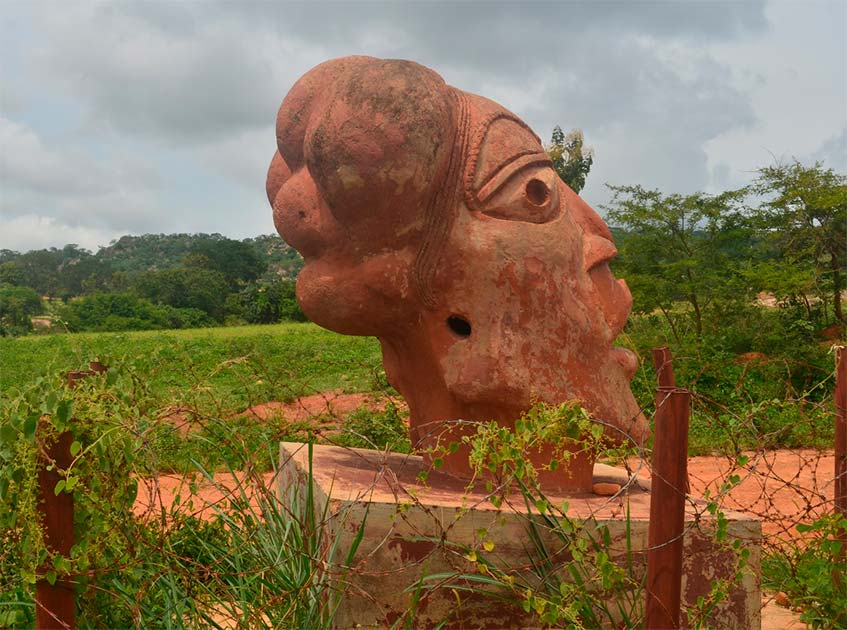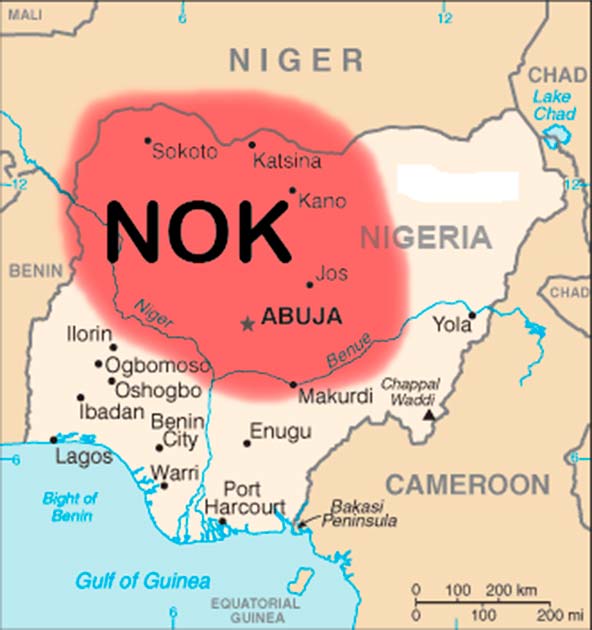When discussing the history of Africa, Ghana and Mali are often described as the “first complex societies in Western Africa”. This is not exactly correct: these were formative and important cultures, dating back to the tenth century, but agriculture developed in Western Africa almost 4,000 years ago.
At this time, the Sahara was not the vast desert we know it as today; rather, it was a grassland area. By around 2,000 BC, things like barley, millet, and cattle were thriving in this area and could sustain large populations.
The thing is, Ghana and Mali were developed three thousand years after farming and agriculture were experienced in Western Africa. This leaves a gap where we don’t know much about what happened in those years.
Archaeologists do have an answer however, with the discovery of the material remains of a culture in today’s modern Nigeria, suggesting large civilizations existed long before the tenth century. Who were these people, known as the Nok, and what happened to them?
The Nok
The Nok culture is one of the earliest known Iron Age societies in Western Africa. It is believed that the Nok society existed in Nigeria from around 500 BC to 200 AD.

What makes the Nok so intriguing however is that their origin is still unknown. Archaeologists have studied the plants the Nok used, including pearl millet, which is indigenous to the Sahel region of Africa. The general consensus is that the Nok likely came from the Sahel zone in West Africa or the Central Sahara.
The Nok people created incredibly detailed terracotta sculptures, which might have been made through large-scale production. It is because of these distinct terracotta sculptures that the Nok were discovered. In 1928, Colonel Dent Young, an owner of a mining business near the village of Nok in Kaduna State, Nigeria, found terracotta sculptures buried 24 feet (7m) underground. The sculptures that Young uncovered were put on display in a museum in the city of Jos.
- Who Built the Abandoned City of Djado? A Saharan Mystery
- Sungbo’s Eredo: The Walls of the Real Queen of Sheba?
It took another 15 years before the clay figurines that Young found were rediscovered. In 1943 workers in a tin mine in the village of Nok found these terracotta figurines. One of the workers in the mine found a clay head and decided to bring it home to use as the head of a scarecrow in a yam field.
Archaeologist Bernard Fagg, who was in Nigeria at the time, spotted this scarecrow and noticed that the head looked very similar to a terracotta sculpture Young found. The culture that created these works of art was unknown and thus given the name of the village closest to where they were found, Nok.
Nok sculptures have been found to date across a huge area of over 78,000 square kilometers (30,116 square miles). Archaeologists have also found over 1,700 pieces of terracotta in an area of only 450 square yards (376 sq m), which illustrates that the Nok had a large population.
Nok pottery was incredibly detailed and has been compared to the Terracotta Warriors in Xian, China. The Nok’s sculptures all share some common features. The figures almost always feature large-headed humans with eyes that are described as almond or slightly triangular eyes, and the figure’s lips are parted.
The sculptures might shine some light on the social status of the Nok society because many of the terracotta figures have “grand headdresses or hairdos,” which archaeologists think could indicate high status. Many of the sculptures have similar poses, a man sitting with his arms resting on his knees with a forward-facing gaze, a position common for metal forgers. The Nok created sculptures depicting warfare, music, love, and even illness.

Sculptures have also been found that show people using bows and arrows as well as slingshots which could suggest that the Nok people participated in hunting or trapping animals for food. The Nok may have used dugout canoes. One discovered sculpture shows “two individuals, along with their goods, in a dugout canoe. Both of the anthropomorphic figures in the watercraft are paddling.”
The choice to depict a dugout canoe in their terracotta statues could indicate that the Nok would use dugout canoes to travel through the tributaries of the Niger River. It is believed that the Nok carried cargo with them and participated in some sort of active trade network in the area.
Smelters of Iron
The Nok are known for their terracotta but also for their utilization of iron. What makes the use of iron by the Nok so intriguing is that they were “one of the very few civilizations in the world that transitioned from stone tools straight to iron tools without first learning how to make copper or bronze tools.”
- Mysterious and Massive: Who Built the Walls of Benin?
- Songhai: The African Empire that Grew Greater than the Mali
Bernard Fagg, who rediscovered the Nok civilization, was shocked to discover around 13 iron-smelting furnaces in the village of Taruga, Nigeria. The technology used to create and smelt iron was believed to have been invented in Eurasia and then spread to Africa much later. Yet Fagg was able to use carbon dating to find the age of charcoal that had been found in the furnaces, and it dated back to 280 BC, and later archeologists dated other charcoal from furnaces back to 500 BC.
The Nok’s metalworking skills were highly advanced for their time. Objects like weapons, tools, and jewelry were created using iron, and their metalworking was believed to be an important part of the Nok’s economy.

However, while there is evidence that the Nok used iron smelting, they also continued to use stone tools at the same time period. This may suggest that the iron/metallic materials were scarce and not widespread. Evidence of manufacturing metal also is a significant marker that society is becoming more complex and advanced, and for the Nok, this occurred earlier than archeologists previously believed.
What Happened to the Nok?
While the Nok left evidence behind to suggest that they were an advanced society with a large population, they simply vanished. Archaeologists have noticed that there was a significant decrease in the volume of pottery and terracotta which suggests that the Nok declined rapidly, and there is no evidence of the Nok’s existence after 200 AD. The reason why the Nok disappeared is unknown.
Archaeologists have suggested that the civilization might have dissolved due to climate change, famine, epidemic, war or invasion, or the overexploitation of natural resources in the area they lived. Some archaeologists believe that the Nok are the ancestors of the modern Yoruba culture in Nigeria.
However, this is just an idea, as no scientific or archaeological evidence supports the belief. Who they are, and where they went, remains a mystery.
Top Image: Nok figurine in a common pose. Source: Javier Ayarza / CC BY-SA 3.0.